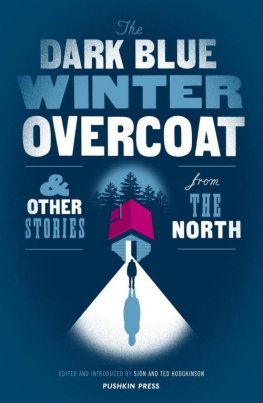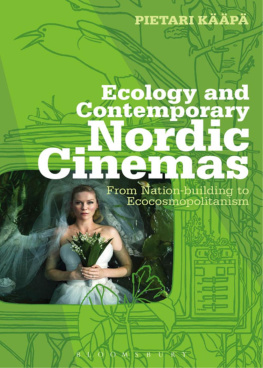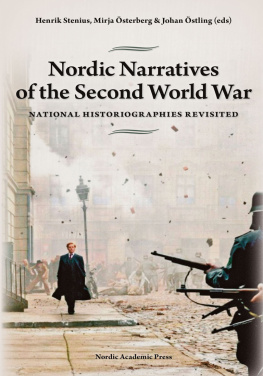THE DARK BLUE WINTER OVERCOAT
AND
OTHER STORIES FROM THE NORTH
Edited and introduced by Sjn and Ted Hodgkinson

Introduction
TED HODGKINSON AND SJN
THE NORTH CONJURES epic storytelling. It is the birthplace of the saga, where stories of human survival have long been sculpted by the regions raw elements, as in turn they have shaped its varied landscapes, from sheltering forests to islands lashed by unforgiving seas. The ancestry of this tradition can be found in many-volumed novels that detail struggles against the headwinds of the modern-day elements, and also in the vicissitudes of Nordic noir, which keep us in suspense, season after season. More than recounting feats of endurance, the storytelling of the region is also alive to the possibilities of human transformation, rooted in the metaphysical world of folklore and fairy tale. The contemporary Nordic short story is a crucible in which these properties are fused together, capturing a quest for survival while prising open, in the space of just a few pages, potential for radical change. These are timely qualities in a world on the brink, in which we need to find ways of reimagining our relationship to our natural surroundings, ourselves and each other.
Sjn is an author uniquely attuned to these storytelling frequencies, who in his own writing across many forms creates historical epics in miniature, focusing on moments of profound transformation, through an often surreal lens. A priest hunts a mysterious blue fox across the stark winter-scape of nineteenth-century Iceland. Or in his most recent novel, a young boy captivated by cinema awakens to his true identity as Spanish flu ravages Reykjavk in 1918. Sjn has brought his own distinctive vision to this first ever selection of short stories from the Nordic region in English, published to coincide with the Southbank Centres Nordic Matters series and the London Literature Festival. Our selection encompasses writers from across generations of each literary culture, to present a prismatic perspective of each place, refracting a broad range of literary styles and human experience. The overall balance of genders reflects a region which has produced some of the finest writers of either gender at work today, though its also especially notable that many of those from the younger generation are women breathing fresh life into the literature of their homelands, including Dorthe Nors, Linda Bostrm Knausgaard and Niviaq Korneliussen. While in recent years many Nordic novelists have found their way into English translation, relatively few of those writers who have focused on the short story have made that same journeythis anthology aims to help close those gaps and create openings into a revelatory world of storytelling.
To introduce the selection, I begin by asking my co-editor Sjn what he sees as the cultural and literary connections between the eight distinctive Nordic lands of Denmark, Norway, Sweden, Finland, the Faroe Islands, land Islands, Greenland and his native Iceland.
* * *
Sjn, the Nordic region covers a vast and varied terrain, both geographically and culturally. What are the things which bind it together? What are the elements that make up a Nordic identity? And after editing this anthology, what have you discovered about the literary links between the writers of the North?
The Nordic identity question is one Nordic authors are repeatedly asked in interviews or on the panels of literary festivals; especially abroad and especially in the context of the Nordic Councils Literature Prize. Their usual reaction to it is to be annoyed at hearing it again, before they answer that there is no common identity; that the literatures of each country have developed in their own specific ways; and so on. But as I take it, the question is really not about our own contemporary literary output but the deeper currents that run under the whole social make-up of the North. So I always try to answer it positively.
The fact that we share history, both cultural and political, that goes back more than a millennium means our societieswhich in the beginning seem to have all been Germanic and heathen, and speaking variants of Old Norsehave been introduced to great historical changes at the same time and had to react to them from that common ground. So the regions movement from the Norse religions to Catholicism, from Catholicism to the Protestant Reformation, from the Reformation to Enlightenment via the Renaissance, from monarchy to democracy and then on to twentieth-century trends in ideologies, art movements and empowerment of social groups, could therefore be seen as one, making us a single culture with regional variations.
The long shared political history is, of course, also a story of wars, invasions, defeats, colonization and the fight for independence among those countriesand thereby of narratives about individuals and communities caught up in those events at the same time while in different parts of the North.
By editing this anthology with you, Ted, I have become even more sure than ever before of how deep the common Nordic roots lie and how consistent authors in the North are in collectively nurturing and feeding from them.
From Johan Bargums haunting story in which a father believes he is a dog, to Hassan Blasims fierce and funny tale of a tiger who is writing a crime novel and drives the 55 bus in Helsinki, to Dorthe Norss spooky story of a man with an injured ankle waiting by a deer stand as darkness falls, many of the stories here capture a moment of transformation, or characters caught on the threshold between worlds. Your writing is also deeply alive to the possibilities of transformation. What makes Nordic writers so imaginatively drawn to the metaphysical, or even the magical?
I think that within much of Nordic literature there are two main tendencies at playthe naturalist school and the folk tradition or diverse common-folks belief systemsand since the beginning of modernity one can see them used together or combined in different measures in most of the best short stories and novels from the region. The naturalists legacy of writing socially relevant storiesand their faith in the authors power to be a voice of change by revealing societys ills with literary meansis still there and responsible for the strong humanist foundation shared by the stories readers will find in this anthology. A part of that humanist worldview is respecting what folk stories have to offer as literature and as the means to understand the universe and mans place in it. And, as you know, once you are therein a forest of stories, on an island of too many tales, in a city of sorrowful rhymesyou are in a world where metamorphosis and transcending the borders of the real and the true are more than just possible, they are tools of survival in harsh natural surroundings or a failing community. Today this can be seen in narratives about changing identities or new sexualities.
Another strong factor in Nordic literature is the early input of the avant-garde in most of the countriessurrealist poetry and the modernist novelwhich on the one hand has resulted in a relentless questioning of the realist method, and on the other in renewing the ways authors can use elements from folk culture in their writing. Add to all of this the influence of diverse strands of Protestant and radical political thinking on Nordic authors and you have a heady brew. Ill stop here, but I am glad you mentioned Hassan Blasim as he and other authors who have come to our countries in the North from faraway places around the globe are already creating new challenges for Nordic literature and moving it forward with their own stories from abroad and within, with references to shape-shifters we couldnt even dream of.








